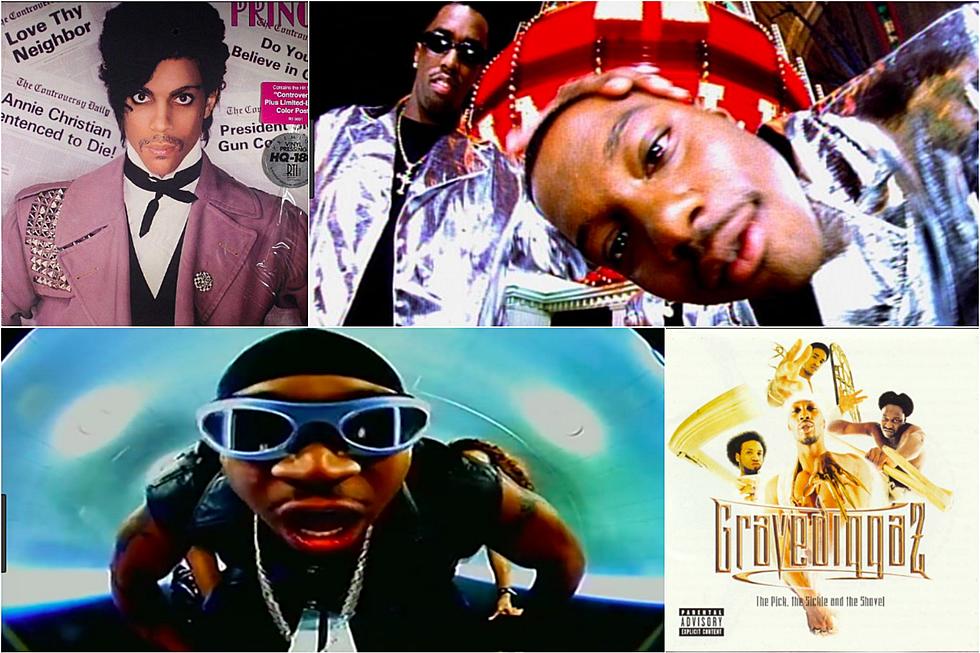
Prince’s ‘Sign O’ the Times': The Last Great Double LP of the Vinyl Era
Prince's creative output throughout the 1980s was staggering. There has never been an artist in pop music with the kind of uber-prolific, stylistically broad and consistently excellent artistic run that Prince had from 1979 to 1989. From his start as an enigmatic funk multi-instrumentalist, to his domination of the pop charts, to his ever-expanding eclecticism as an established superstar--Prince showed a breathless capacity for reinvention that rivaled David Bowie while commanding the kind of pop star cache that defined (and somewhat stifled) peers like Michael Jackson and Madonna. And by 1987, Prince showed no signs of slowing down in any way.
The superstar had already churned out a staggering six albums over the previous six years, all while filming two movies (1984s Purple Rain and 1986s Under the Cherry Moon), performing on three major tours (and three smaller ones), and writing and/or producing hits for artists like Sheila E and the Bangles; as well as working on several side projects via acts like The Time, Vanity 6, Madhouse and Mazarati. In spring 1986, Prince would have the No. 1 song in the U.S. with "Kiss." And No. 2 was the Bangles hit "Manic Monday," which was also written by Prince.
The genesis of what would become Prince's highest artistic achievement began at the end of 1985, when he and his band The Revolution, fresh off the recording sessions for Parade, began work on an ambitious double album called Dream Factory. He'd also been recording with an impromptu touring band that included Sheila E. and Levi Seacer; with the prospect of working with jazz legend Miles Davis also lingering. Many of those sessions never materialized into actual releases, but in 1986, Prince and the Revolution began recording tracks with engineers at his new home studio. Songs like "Ballad of Dorothy Parker," "Strange Relationship," "Starfish & Coffee" and "Sexual Suicide" materialized early; with other tracks like "It," "I Could Never Take the Place of Your Man," and "Crystal Ball" being recorded later in the sessions. He would go on tour of Europe that summer, and a soundcheck would result in the Revolution-assisted rave-up "It's Gonna Be A Beautiful Night."
"...Dorothy Parker" featured a muted vocal and lyrics referencing Joni Mitchell, as Prince sang about a beautiful "waitress on the promenade" who invites him back to her place. "Starfish & Coffee" was one of Prince's more innocently childlike tunes; a wistful ode to a grade school girl named "Cynthia Rose" who made everyone else seem "ordinary." And the thumping pop of "Strange Relationship," as the title suggests, was Prince looking at the complexities of committed love--possibly driven by his ever-changing relationship with Susannah Melvoin, his girlfriend at the time and sister to his creative caporegime from The Revolution, Wendy Melvoin.
He recorded "Sign O' the Times" and "The Cross" almost entirely alone; both songs building on topicality he'd shown throughout his career--but now it was being delivered in a starkly minimalist musical package. For all of the chatter about "empty" pop music during the 1980s, Prince hadn't shied away from addressing politics and spirituality as far back as the Controversy album. Now, with AIDS, Iran-Contra, Wall Street crashes and environmental concerns dominating late 80s headlines, Prince's perspective on such matters was front-and-center. "Sign O' the Times" addressed "17 year old boys" who's "idea of fun is being in a gang called The Disciples, high off crack and toting a machine gun" and the AIDS epidemic ("a big disease with a little name"); while "The Cross" showcased the kind of stripped sound reminiscent of the Velvet Underground, as Prince sang about faith in the face of pain, and belief in the Second Coming.
But shifts were on the horizon. That 1986 Parade Tour had led to frustrations within Prince's musical collective. He'd expanded The Revolution to include some members of The Family, his now-dismantled funk/new wave outfit that had been a successor to The Time, and it led to tensions amongst the members, particularly bassist BrownMark and drummer Bobby Z. There'd been bright moments on the European leg, such as Prince being joined onstage by Sting and Ronnie Wood when they performed in Britain, but hostilities between he and the Revolution had gotten to the point where change was imminent as the tour wound down and Prince returned to the studio.
As he was recording less and less with The Revolution, Prince made the formal decision to fire his most famous backing band in late 1986. Despite the problems on The Parade Tour, Wendy Melvoin and Lisa Coleman would later say they didn't see it coming. "If we had been looking, there were probably signs," said Melvoin in 1987. "But maybe the signs were there and we just didn't want to see them.
"He had been working more on his own than usual," added Coleman. "We weren't with him in the studio as much."
With The Revolution gone, so was Dream Factory. Prince tossed the album in favor of pushing ahead in a new direction on his own. The first post-Revolution track he recorded was "Housequake," a digital funk monster with a skittering-yet-lumbering beat that sounded like the love child of James Brown and Run-D.M.C. He also wrote songs (under the pseudonym "Joey Coco") for country stars Kenny Rogers and Deborah Allen ("You're My Heart" appeared on Roger's 1986 album They Don't Make Them Like They Used To and "Telepathy" was a single for Allen in 1987), turned down an invite to guest on Michael Jackson's "Bad" and was working on a script for a musical. It was a tremendous workload, especially considering he was still recording tracks for a new album. His toying with vocal alterations had given birth to a new feminine alter-ego dubbed "Camille," and Prince was planning an EP of Camille songs that included the starkly beautiful "If I Was Your Girlfriend."
Challenging ideas of masculinity/femininity had always been a part of Prince's image and musical identity, but it had never been used to such poignant effect as on the smokey, mysteriously bittersweet "...Girlfriend," which poses the question of what intimacy truly means when it's between lovers as opposed to friends, with a gender-bending subtext that led to countless interpretations.
By now, Prince's ambitions were spiraling in countless directions--and he decided ultimately to release a collection of these new songs as a triple album called Crystal Ball. The proposed album would become one of the most mythologized projects in Prince's oeuvre. Warner Bros famously balked at the idea of one of the biggest artists in music releasing a three-LP set; Prince hadn't exactly churned out a string of commercial blockbusters following the immense success of the Purple Rain film and soundtrack in 1984. Multiple side projects, an unyielding creative restlessness which led to albums that sometimes confused critics and the public, the litany of songs and proposed ideas Prince had floating in the ether--it all seemed to be too much for anyone to succinctly manage and market. Prince was told to pare it down. Begrudgingly, he complied.
He trimmed the songs from Crystal Ball down, and added some noteworthy stray songs from his famed Vault: "I Could Never Take the Place of Your Man" was a lengthy slice of guitar-driven pop-rock that was re-recorded and featured one of Prince's greatest guitar solos, "U Got the Look" was a duet with one of his more famous muses in pop star Sheena Easton and had the thriving club vibe of his most radio-friendly mid-80s period, and "Adore" was a newly recorded R&B ballad that channels classic Philly soul with its gorgeous horns (courtesy of Atlanta Bliss and Eric Leeds) and sweetly sentimental lyric. It stands as arguably the greatest love song Prince, or anyone else, ever released.
Now called Sign O' the Times, Warner Bros happily accepted the new double album and the project was released on March 31, 1987. The album was widely hailed; it was named 1987's best album in the Pazz & Jop Critics Poll and nominated for Album of the Year at the 1988 Grammy Awards (it lost to U2's Joshua Tree.) With its wide array of sounds and styles, it represents Prince at a creative apex--even with it's convoluted history. And it's not just a collection of genre exercises; this is still Prince pushing sonic boundaries, not simply relying on variety to convey versatility. With it's woozy synths and beats, the grunt of "Hot Thang" doesn't sound like the funk of Prince's early 1980s Minneapolis Sound at all; the light psychedelia of "Play In the Sunshine" never feels like a retread of anything he'd done on Around the World In A Day; the stripped-down, pulsing "Forever In My Life" sounds like an entirely unique creation and the bright horns of the Carole Davis collaboration "Slow Love" isn't an exercise in anything resembling standard 80s R&B balladry.
The double album is traditionally popular music's greatest indulgence. Even the most acclaimed double LPs feature some kind of excess; whether it be the weirder excursions on The Beatles' "White Album," the druggy genre-hopping of The Rolling Stones' Exile On Main St., or the more on-the-nose thematic moments of Stevie Wonders' Songs In the Key of Life. By the late 1980s, double albums by major stars were becoming much less fashionable; amongst the biggest pop stars of the era, only Bruce Springsteen had released a double LP in the 1980s--and The River was released four years before he actually became a crossover pop star in the wake of the blockbuster success of 1984s Born In the U.S.A.
Prince himself had originally released 1982s 1999 as a double LP on vinyl, but in 1987, the compact disc had emerged as the new popular format, and with it came the luxury of recording more tracks than ever on a single disc. With the CD revolution, double albums wouldn't necessarily become less prevalent, but they would become much gaudier and overblown. Classic 1990s double albums like Mellon Collie & the Infinite Sadness or All Eyez On Me wallow in indulgence by way of the very format in which they were released (All Eyez... is almost an hour longer than Sign O' the Times, for example), which gives SOTT a unique place in music history. It not only stands as Prince's greatest artistic achievement--no album better showcases the breadth of his talents as a musician, producer and songwriter while also highlighting his creative ambition and penchant for boundary-pushing--but also, it stands as the last great double LP of the vinyl era. It's the last truly brilliant double album before CDs made them ridiculous; and the last great double album of the rock era. That it's flawless is even more remarkable, given its complex history.
1999 was the breakthrough and Purple Rain was the blockbuster, but Sign O' the Times is the best representation of Prince's genius. If you're looking for the perfect distillation of everything that made Prince amazing and if you need proof that bold creativity was not at all dwindling in the MTV-centric 1980s, look no further than Prince's magnum opus from 1987. Prince Rogers Nelson was as close as we got to a Miles Davis in pop music, but more than that, he was a uniquely brilliant artist who delivered an album of unparalleled highs and undeniable riches.
And 30 years later, it still sounds ahead of the times.
More From TheBoombox









